Impact of COVID-19 on High Street Retail Industry: A Case Study of John Lewis and Partners
Added on 2023-06-11
33 Pages11499 Words412 Views
Impact of the coronavirus COVID-19
pandemic on the declining high street retail
industry in the UK: A case study of John
Lewis and Partners
pandemic on the declining high street retail
industry in the UK: A case study of John
Lewis and Partners
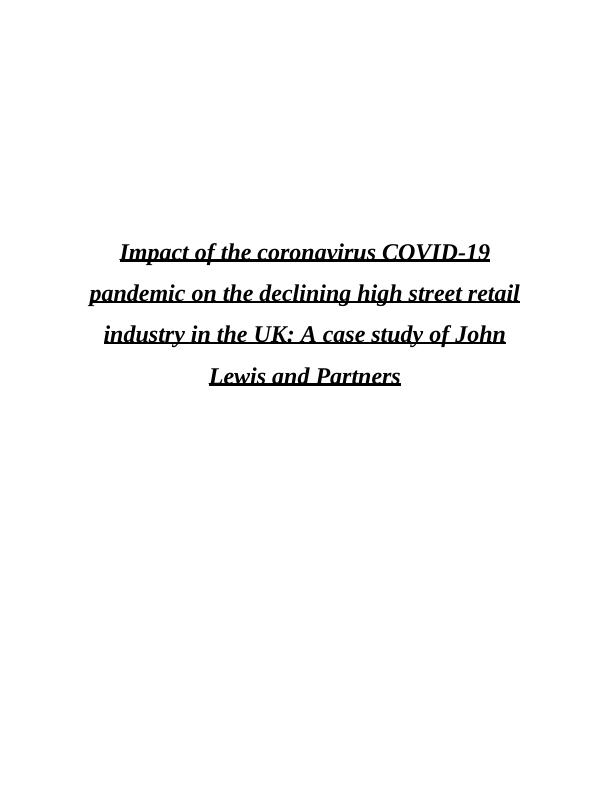
Table of Contents
INTRODUCTION...........................................................................................................................3
Overview of the topic.............................................................................................................3
Background of the organisation..............................................................................................4
Research Questions................................................................................................................4
Research Aim.........................................................................................................................4
Research Objective.................................................................................................................5
Rationale of the research........................................................................................................5
LITERATURE REVIEW................................................................................................................6
What was the condition of the high street retail industry just before the outbreak of
coronavirus pandemic?...........................................................................................................6
What kind of strategic decisions were taken in the history of JLP resulted the fact that it was
in a relatively favourable position at the time of the outbreak of the pandemic?..................7
What is the impact of COVID-19 on high street retail industry?...........................................9
What are tactical strategies JLP needed to apply for survival and future success during
pandemic?.............................................................................................................................10
CHAPTER 3: RESEARCH METHODOLOGY...........................................................................12
CHAPTER 4: RESULTS AND DISCUSSION.............................................................................16
CONCLUSION AND RECOMMENDATION.............................................................................25
REFERENCES..............................................................................................................................30
INTRODUCTION...........................................................................................................................3
Overview of the topic.............................................................................................................3
Background of the organisation..............................................................................................4
Research Questions................................................................................................................4
Research Aim.........................................................................................................................4
Research Objective.................................................................................................................5
Rationale of the research........................................................................................................5
LITERATURE REVIEW................................................................................................................6
What was the condition of the high street retail industry just before the outbreak of
coronavirus pandemic?...........................................................................................................6
What kind of strategic decisions were taken in the history of JLP resulted the fact that it was
in a relatively favourable position at the time of the outbreak of the pandemic?..................7
What is the impact of COVID-19 on high street retail industry?...........................................9
What are tactical strategies JLP needed to apply for survival and future success during
pandemic?.............................................................................................................................10
CHAPTER 3: RESEARCH METHODOLOGY...........................................................................12
CHAPTER 4: RESULTS AND DISCUSSION.............................................................................16
CONCLUSION AND RECOMMENDATION.............................................................................25
REFERENCES..............................................................................................................................30

INTRODUCTION
Overview of the topic
COVID 19 has created a huge impact on the performance and growth of business. The
crisis has hit the profitability of companies due to which they faced severe loss. All the business
sector is badly hit due to pandemic due to shortage of migrant workers, less demand, reduces
cash flows and supply chain disruption (Lu and et. al., 2021). The crisis has sent shockwaves
throughout global communities, financial markets and dislocated international supply chains. In
order to sustain in COVID 19, organisations are focusing on adapting new working style. Retail
industry is one of the industry which have faced great influence on its business performance due
to pandemic. The crisis has changed the external environment of retail industry (Tang and et. al.,
2021). They have suffered a lot due to pandemic as government imposed lock-down and asked
people to quarantine themselves in order to reduce the impact of pandemic. The lifestyle of
consumers also gets changed in crisis as they are shifting towards online purchase rather than
going into market for shopping. Due to lock-down people are purchasing products and services
online and also they are working by sitting at home (Pagano, Sedunov and Velthuis, 2021). The
retail business has requested government to continue essential business in order to fulfil the food
and daily necessities of people. Retailers of shopping goods and luxury items faces problem in
pandemic. COVID 19 has influenced the retail and shopping industry as many brick and mortar
stores are being forced to close their outlets. In order to cope up with the negative impact of
pandemic, retail industry is identifying new ways for reaching the customers. The retail
organisations that have strong presence on online platforms as well as offline platforms can
respond more steadily whereas retailers with physical stores are struggling to adjust (Islam and
et. al., 2021). Lock-down has influenced the profitability and growth of business as physical
stores are forced to shut down and also they were not able to welcome walk-in customers,
production of clothing has come to a stand-fill as factories were forced to close, people are
shifting towards online shopping and also need for purchasing new garments also get reduced
(Mason, Narcum and Mason, 2020). Thus, the factors which creates an impact on the retail
industry are digital storefronts, sustainable fashion, increased awareness and engagement and
green washing. This research provides detailed information related to the impact of the
coronavirus COVID-19 pandemic on the declining high street retail industry in the UK. In this
Overview of the topic
COVID 19 has created a huge impact on the performance and growth of business. The
crisis has hit the profitability of companies due to which they faced severe loss. All the business
sector is badly hit due to pandemic due to shortage of migrant workers, less demand, reduces
cash flows and supply chain disruption (Lu and et. al., 2021). The crisis has sent shockwaves
throughout global communities, financial markets and dislocated international supply chains. In
order to sustain in COVID 19, organisations are focusing on adapting new working style. Retail
industry is one of the industry which have faced great influence on its business performance due
to pandemic. The crisis has changed the external environment of retail industry (Tang and et. al.,
2021). They have suffered a lot due to pandemic as government imposed lock-down and asked
people to quarantine themselves in order to reduce the impact of pandemic. The lifestyle of
consumers also gets changed in crisis as they are shifting towards online purchase rather than
going into market for shopping. Due to lock-down people are purchasing products and services
online and also they are working by sitting at home (Pagano, Sedunov and Velthuis, 2021). The
retail business has requested government to continue essential business in order to fulfil the food
and daily necessities of people. Retailers of shopping goods and luxury items faces problem in
pandemic. COVID 19 has influenced the retail and shopping industry as many brick and mortar
stores are being forced to close their outlets. In order to cope up with the negative impact of
pandemic, retail industry is identifying new ways for reaching the customers. The retail
organisations that have strong presence on online platforms as well as offline platforms can
respond more steadily whereas retailers with physical stores are struggling to adjust (Islam and
et. al., 2021). Lock-down has influenced the profitability and growth of business as physical
stores are forced to shut down and also they were not able to welcome walk-in customers,
production of clothing has come to a stand-fill as factories were forced to close, people are
shifting towards online shopping and also need for purchasing new garments also get reduced
(Mason, Narcum and Mason, 2020). Thus, the factors which creates an impact on the retail
industry are digital storefronts, sustainable fashion, increased awareness and engagement and
green washing. This research provides detailed information related to the impact of the
coronavirus COVID-19 pandemic on the declining high street retail industry in the UK. In this
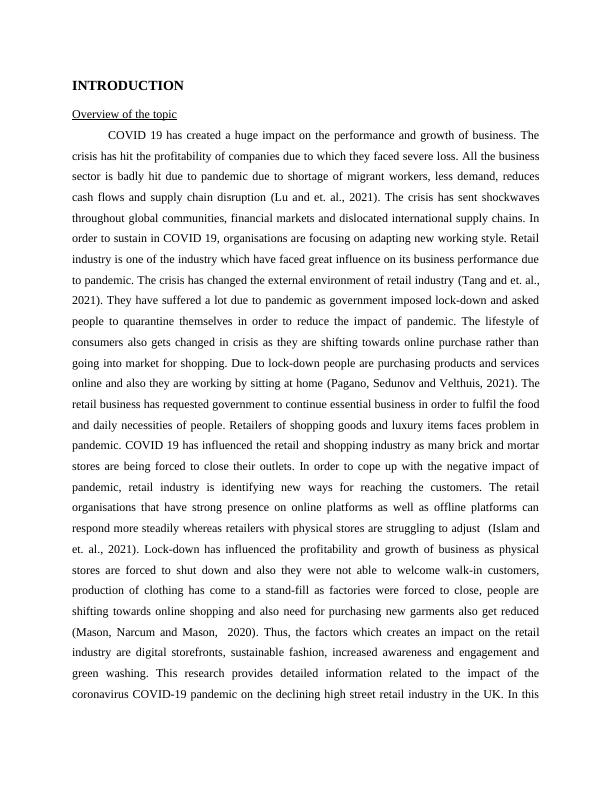
research, researcher will focus on identifying the condition of high street retail industry just
before the outbreak of coronavirus pandemic. It also focuses on determining the impact of
COVID-19 on high street retail industry and strategies require for survival and future success
(Sharma and Jhamb, 2020).
Background of the organisation
The chosen organisation for this research is John Lewis and Partners, it is a reputed
departmental store which was founded by John Lewis. The brand was founded in 1864 with a
motive to provide wide range of products and services to its customer. It is a retail brand that
operates home stores, convenience stores, department stores and supermarkets in UK. One of
the major strength of the brand is it is largest employee owned business that means employee are
the co-owner of the brand. Due to partnership employee enjoy the right of ownership in the
company which differentiate the brand from the other competitors in the world. Company also
have strong online presence in order to attract maximum number of customer towards the brand.
They have their own website which provides detailed information related to company, products
and services. The main purpose of John Lewis is to create fairer and successful business by
encouraging sustainability. Target market of organisation is upper and middle class people with
an age of 30 to 40. The brand is focused on brining positive change, building more sustainable
future and improving lives of people. John Lewis and Partnership ensures that their customer
may feel satisfied with the products and services in order to create strong customer base and
improve the profitability of business.
Research Questions
What was the condition of the high street retail industry just before the outbreak of
coronavirus pandemic?
What kind of strategic decisions were taken in the history of JLP resulted the fact that it
was in a relatively favourable position at the time of the outbreak of the pandemic?
What is the impact of COVID-19 on high street retail industry?
What are tactical strategies JLP needed to apply for survival and future success during
pandemic?
before the outbreak of coronavirus pandemic. It also focuses on determining the impact of
COVID-19 on high street retail industry and strategies require for survival and future success
(Sharma and Jhamb, 2020).
Background of the organisation
The chosen organisation for this research is John Lewis and Partners, it is a reputed
departmental store which was founded by John Lewis. The brand was founded in 1864 with a
motive to provide wide range of products and services to its customer. It is a retail brand that
operates home stores, convenience stores, department stores and supermarkets in UK. One of
the major strength of the brand is it is largest employee owned business that means employee are
the co-owner of the brand. Due to partnership employee enjoy the right of ownership in the
company which differentiate the brand from the other competitors in the world. Company also
have strong online presence in order to attract maximum number of customer towards the brand.
They have their own website which provides detailed information related to company, products
and services. The main purpose of John Lewis is to create fairer and successful business by
encouraging sustainability. Target market of organisation is upper and middle class people with
an age of 30 to 40. The brand is focused on brining positive change, building more sustainable
future and improving lives of people. John Lewis and Partnership ensures that their customer
may feel satisfied with the products and services in order to create strong customer base and
improve the profitability of business.
Research Questions
What was the condition of the high street retail industry just before the outbreak of
coronavirus pandemic?
What kind of strategic decisions were taken in the history of JLP resulted the fact that it
was in a relatively favourable position at the time of the outbreak of the pandemic?
What is the impact of COVID-19 on high street retail industry?
What are tactical strategies JLP needed to apply for survival and future success during
pandemic?
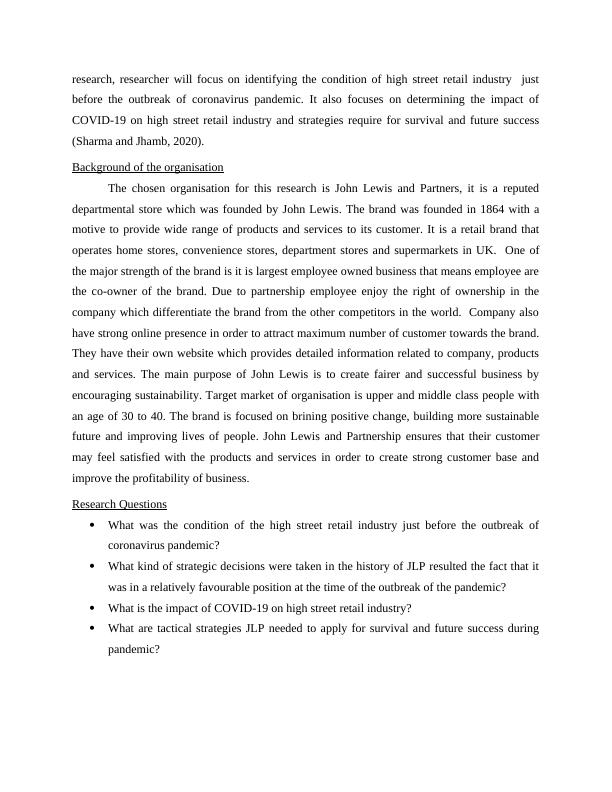
Research Aim
The aim of this research is to investigate the factors why JLP is one of the survivors of
the coronavirus COVID-19 pandemic crisis.
Research Objective
To determine the status of the high street retail industry before the Coronavirus pandemic
(late 2010s)
To investigate the most important strategic decisions taken by JLP during its more than
150 years history before COVID-19.
To examine the impact of the pandemic crisis on high street retail industry: losers and
survivors.
To describe and analyse how JLP adapted during the pandemic and the vision of the
company about its future after the plague.
Rationale of the research
The main reason for conducting this research is to avail in-depth knowledge about the
impact of the coronavirus COVID-19 pandemic on the declining high street retail industry in the
UK. It also helps in determining the status of the high street retail industry before the
Coronavirus pandemic and also investigate the most important strategic decisions taken by
organisation before pandemic. This research also provide information regarding the impact of the
pandemic crisis on high street retail industry and analyse the ways through which organisation
can survive in the tough time of pandemic. While conducting this report, I will an opportunity to
fulfil my personal and professional objective. I will also learnt about how COVID 19 has hit the
retail industry. It also helps me in determining the strategies which company can use in order to
deal with the negative impact of COVID 19. Moreover, I will also grab a knowledge related to
the company and their action during pandemic.
The aim of this research is to investigate the factors why JLP is one of the survivors of
the coronavirus COVID-19 pandemic crisis.
Research Objective
To determine the status of the high street retail industry before the Coronavirus pandemic
(late 2010s)
To investigate the most important strategic decisions taken by JLP during its more than
150 years history before COVID-19.
To examine the impact of the pandemic crisis on high street retail industry: losers and
survivors.
To describe and analyse how JLP adapted during the pandemic and the vision of the
company about its future after the plague.
Rationale of the research
The main reason for conducting this research is to avail in-depth knowledge about the
impact of the coronavirus COVID-19 pandemic on the declining high street retail industry in the
UK. It also helps in determining the status of the high street retail industry before the
Coronavirus pandemic and also investigate the most important strategic decisions taken by
organisation before pandemic. This research also provide information regarding the impact of the
pandemic crisis on high street retail industry and analyse the ways through which organisation
can survive in the tough time of pandemic. While conducting this report, I will an opportunity to
fulfil my personal and professional objective. I will also learnt about how COVID 19 has hit the
retail industry. It also helps me in determining the strategies which company can use in order to
deal with the negative impact of COVID 19. Moreover, I will also grab a knowledge related to
the company and their action during pandemic.

LITERATURE REVIEW
What was the condition of the high street retail industry just before the outbreak of coronavirus
pandemic?
As per the viewpoint of Rodgers and et. al., (2021), the condition of high street industry
just before the outbreak of pandemic was growing by offering high quality of products and
services to its customer. The sale of the retail industry was increasingly rapidly in 2010's due to
which the profitability and growth of retail industry increases. For lifting the sales of clothing
and shoes, summer sales, school holidays and warmer weather helps in increasing the sale and
profit margin of high street retail sector. Before the outbreak of pandemic. High street retail
industry focuses on attracting its customer by offering them products according to the new and
latest trends. In 2010, high street retail industry was not so wide they offer limited number of
varieties to its customer. The era brings boom in high street retail industry due to which they
focuses on understanding the customer preference and provides them products according to their
need and expectations. The fashion in 2010 was becoming modern and also improving the living
standard of people. Before the outbreak of pandemic, the store openings are increasing in order
to provide varieties of products and services to its customer. The high street retail industry is also
focusing one expanding their reach to large number of customer in order to increase the
profitability and productivity of business (Heller and et. al., 2019). There are various factors
which influence and stimulate change on high street such as price, quality, quantity and many
others. In 2010, the price of the products were low which attracts maximum number of people
towards the brand. The high street retail industry lay emphasis on providing better quality of
products at affordable price to its customer. Due to emergence of internet, high street retail
industry is growing their business rapidly which helps in increasing the profitability and
performance of business. With the help of internet, industry is reaching to wide range of
audience in order to promote their business and increase the sale of business. Internet helps
industry to create strong customer base by offering them products and services according to their
need and expectations. In 2010, high street retail industry has started to focus on understanding
the needs and requirements of customers so that they can attain business goals and objectives.
The high street retail industry also focuses on following the latest trends and fashion in order to
remain competitive in market.
What was the condition of the high street retail industry just before the outbreak of coronavirus
pandemic?
As per the viewpoint of Rodgers and et. al., (2021), the condition of high street industry
just before the outbreak of pandemic was growing by offering high quality of products and
services to its customer. The sale of the retail industry was increasingly rapidly in 2010's due to
which the profitability and growth of retail industry increases. For lifting the sales of clothing
and shoes, summer sales, school holidays and warmer weather helps in increasing the sale and
profit margin of high street retail sector. Before the outbreak of pandemic. High street retail
industry focuses on attracting its customer by offering them products according to the new and
latest trends. In 2010, high street retail industry was not so wide they offer limited number of
varieties to its customer. The era brings boom in high street retail industry due to which they
focuses on understanding the customer preference and provides them products according to their
need and expectations. The fashion in 2010 was becoming modern and also improving the living
standard of people. Before the outbreak of pandemic, the store openings are increasing in order
to provide varieties of products and services to its customer. The high street retail industry is also
focusing one expanding their reach to large number of customer in order to increase the
profitability and productivity of business (Heller and et. al., 2019). There are various factors
which influence and stimulate change on high street such as price, quality, quantity and many
others. In 2010, the price of the products were low which attracts maximum number of people
towards the brand. The high street retail industry lay emphasis on providing better quality of
products at affordable price to its customer. Due to emergence of internet, high street retail
industry is growing their business rapidly which helps in increasing the profitability and
performance of business. With the help of internet, industry is reaching to wide range of
audience in order to promote their business and increase the sale of business. Internet helps
industry to create strong customer base by offering them products and services according to their
need and expectations. In 2010, high street retail industry has started to focus on understanding
the needs and requirements of customers so that they can attain business goals and objectives.
The high street retail industry also focuses on following the latest trends and fashion in order to
remain competitive in market.
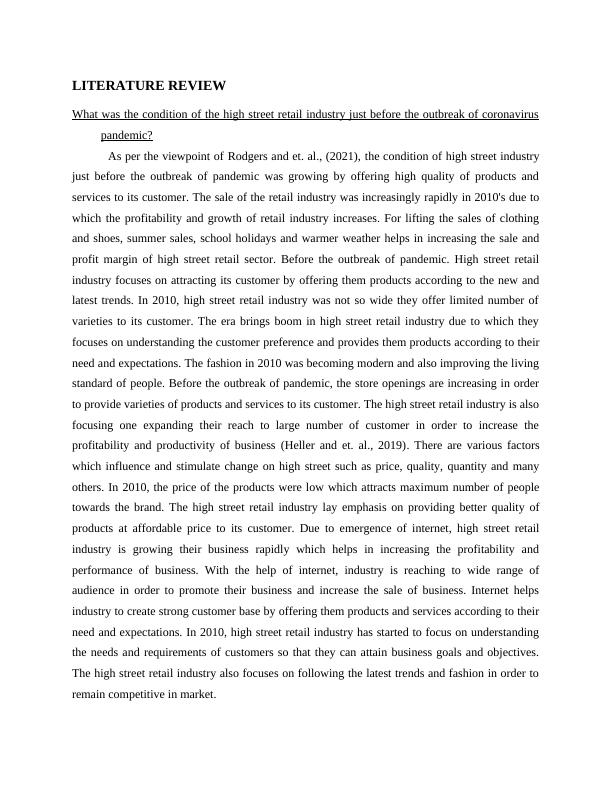
The pandemic has changed the way people use high street due to the change in consumer buying
behaviour. With the adoption of purchasing good through online mode the company is market
share shirked before the time of Covid 19 pandemic. The internet sale was raised by 21 percent
as compared to the retail sale of the high street. In-fact when the lockdown was announced it has
largely affected the high street because consumer willingness to buy the product decreases. The
sale of high street shop has declined to 45 percent which was the largest footfall as compared to
past years. The retail sale after the lock down period has jumped to 33 percent. Before the
pandemic to the market share of the company shrink and after the hit of the pandemic it worst
affect the John Lewis and its partners. The tendency of the high street stores has declined which
resulted in lower income and revenue. The survival becomes difficult after the Covid 19 raise.
What kind of strategic decisions were taken in the history of JLP resulted the fact that it was in a
relatively favourable position at the time of the outbreak of the pandemic?
According to Lee and Charles, (2021), John Lewis is one of the largest employee owned
organisation so as employee are not only treated as employee they are called partners. The crisis
of COVID-19 has diminished the fashion industry as due to different lock-down the industry has
shattered. The company has adopted different safety measures in their organisation and this is the
major reason that the organisation was at relatively favourable position at the time of pandemic
in comparison to other competitors. The organisation is meeting risk assessment procedure so
that different risks can be identified and at the same time various measures can also be taken.
The major reason of spreading of COVID-19 is related with transmission and due to this JLP had
to take various decisions so that they can minimise the spread of coronavirus. The company has
adopted practical measures due to which different working activities were initiated in additional
manner (O’Dochartaigh, 2019). The organisation has taken various preventive measures so that
to provide safe environment to their employees and customers. John Lewis partnership has
initiated to use different measures by which transmission risk of the virus has decreased and in
the same manner hygiene standards were also maintained. The company also tracked personal
data so that test and tracing procedure can be exerted. The organisation also managed their
business functions under the COVID-19 protocols so that to keep their customers informed
related with their methods.
The high street retail industry have transformed after the implication of COVID-19 and
this transformation is compounding in every day. The organisation is highly aware regarding
behaviour. With the adoption of purchasing good through online mode the company is market
share shirked before the time of Covid 19 pandemic. The internet sale was raised by 21 percent
as compared to the retail sale of the high street. In-fact when the lockdown was announced it has
largely affected the high street because consumer willingness to buy the product decreases. The
sale of high street shop has declined to 45 percent which was the largest footfall as compared to
past years. The retail sale after the lock down period has jumped to 33 percent. Before the
pandemic to the market share of the company shrink and after the hit of the pandemic it worst
affect the John Lewis and its partners. The tendency of the high street stores has declined which
resulted in lower income and revenue. The survival becomes difficult after the Covid 19 raise.
What kind of strategic decisions were taken in the history of JLP resulted the fact that it was in a
relatively favourable position at the time of the outbreak of the pandemic?
According to Lee and Charles, (2021), John Lewis is one of the largest employee owned
organisation so as employee are not only treated as employee they are called partners. The crisis
of COVID-19 has diminished the fashion industry as due to different lock-down the industry has
shattered. The company has adopted different safety measures in their organisation and this is the
major reason that the organisation was at relatively favourable position at the time of pandemic
in comparison to other competitors. The organisation is meeting risk assessment procedure so
that different risks can be identified and at the same time various measures can also be taken.
The major reason of spreading of COVID-19 is related with transmission and due to this JLP had
to take various decisions so that they can minimise the spread of coronavirus. The company has
adopted practical measures due to which different working activities were initiated in additional
manner (O’Dochartaigh, 2019). The organisation has taken various preventive measures so that
to provide safe environment to their employees and customers. John Lewis partnership has
initiated to use different measures by which transmission risk of the virus has decreased and in
the same manner hygiene standards were also maintained. The company also tracked personal
data so that test and tracing procedure can be exerted. The organisation also managed their
business functions under the COVID-19 protocols so that to keep their customers informed
related with their methods.
The high street retail industry have transformed after the implication of COVID-19 and
this transformation is compounding in every day. The organisation is highly aware regarding
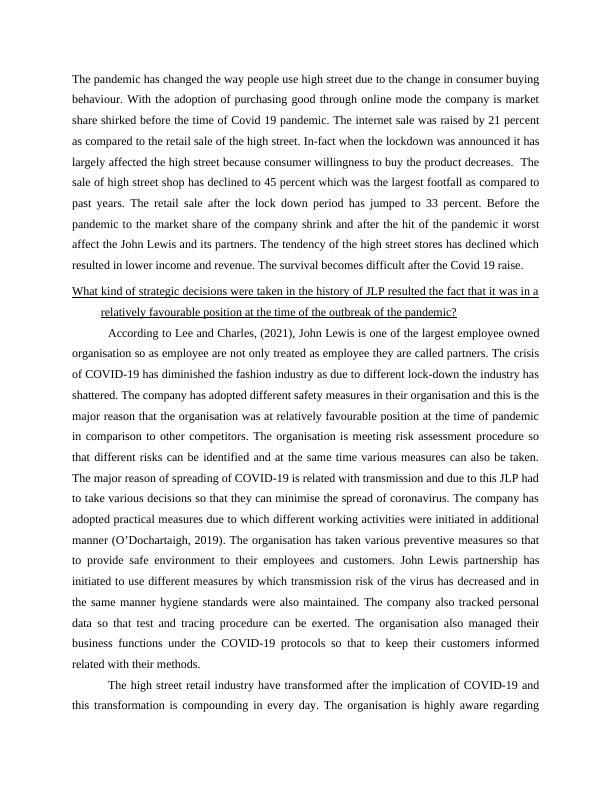
needs of their shoppers which is important in order to manage long edged business. The
company is investing to their partners and customers which is one of the greatest value and
assisted the organisation to deal with the crisis of COVID-19. John Lewis partnership has
decided their priority to minimise overall business cost so that the organisation can be saved to
bear unpredicted losses. The company has initiated to make partnership with growth aspects so
that unique strengths can be provided to the business such as dealing with needs of customers
(Hewidy and Lilius, 2022). John Lewis partnership has moved online in order to deal with needs
of their customers and the company has used different multi-channels services so that to manage
their business amid COVID-19. Half of the overall sales of John Lewis partnership was
conducted using online methods. Besides this using different advertising policies the
organisation has changed buying behaviour of their customer which is one of the necessary step
in order to align their customers with online shopping (Benziman, 2020). The social media
presence is developed by the organisation which is helping the organisation to manage their
business functions during the crisis of COVID-19.
The JLP owns and operates two of the most loved British retail brands which are John
Lewis and Waitrose partners. It is one of the leading partnership companies which have more
than 78000 employees who are the Co-owners of the business. One of the biggest assets of the
company is that the partners are the social enterprise of the company because the profits earned
by them are reinvested back into the company. The John Lewis and Waitrose partnership has 332
stores which were located across England, Scotland, Wales and island. Through their online
application the company sale it’s product to more than 50 countries. In UAE they operates there
business through the acquisition of licensee and has 13 shops over the country.
JLP has initiated their business as innovation partnership in which the organisation is
considered as the largest retail innovation in which the organisation has enabled different start-
ups and established to pitch their innovative services and products into the business. The
company from its beginning developing new value proposition customers which is one of the
helpful measure for the organisation in which the company is at better stage from their
competitors. The company also very much adaptive in using technology in their business as they
are performing trials in robots which is one of the future steps for the organisation in which the
company was able to deal with the situation of COVID-19. The major objective of the
organisation is to create trust among people so that sustainable future can be developed. The
company is investing to their partners and customers which is one of the greatest value and
assisted the organisation to deal with the crisis of COVID-19. John Lewis partnership has
decided their priority to minimise overall business cost so that the organisation can be saved to
bear unpredicted losses. The company has initiated to make partnership with growth aspects so
that unique strengths can be provided to the business such as dealing with needs of customers
(Hewidy and Lilius, 2022). John Lewis partnership has moved online in order to deal with needs
of their customers and the company has used different multi-channels services so that to manage
their business amid COVID-19. Half of the overall sales of John Lewis partnership was
conducted using online methods. Besides this using different advertising policies the
organisation has changed buying behaviour of their customer which is one of the necessary step
in order to align their customers with online shopping (Benziman, 2020). The social media
presence is developed by the organisation which is helping the organisation to manage their
business functions during the crisis of COVID-19.
The JLP owns and operates two of the most loved British retail brands which are John
Lewis and Waitrose partners. It is one of the leading partnership companies which have more
than 78000 employees who are the Co-owners of the business. One of the biggest assets of the
company is that the partners are the social enterprise of the company because the profits earned
by them are reinvested back into the company. The John Lewis and Waitrose partnership has 332
stores which were located across England, Scotland, Wales and island. Through their online
application the company sale it’s product to more than 50 countries. In UAE they operates there
business through the acquisition of licensee and has 13 shops over the country.
JLP has initiated their business as innovation partnership in which the organisation is
considered as the largest retail innovation in which the organisation has enabled different start-
ups and established to pitch their innovative services and products into the business. The
company from its beginning developing new value proposition customers which is one of the
helpful measure for the organisation in which the company is at better stage from their
competitors. The company also very much adaptive in using technology in their business as they
are performing trials in robots which is one of the future steps for the organisation in which the
company was able to deal with the situation of COVID-19. The major objective of the
organisation is to create trust among people so that sustainable future can be developed. The
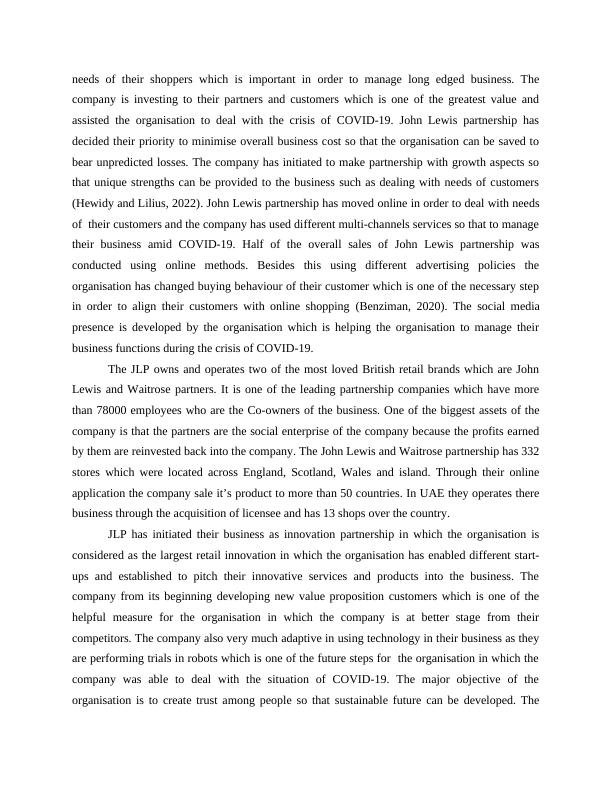
End of preview
Want to access all the pages? Upload your documents or become a member.
Related Documents
Impact of COVID-19 on High Street Retail Industry: A Case Study of John Lewis and Partnerslg...
|24
|9738
|217
Impact of the coronavirus COVID-19 pandemic on the declining high street retail industry in the UK: A case study of John Lewis and Partnerslg...
|16
|3936
|136
Effects of COVID-19 on Marriott Hotel: A Study on Productivity of UK Hospitality Industrylg...
|12
|2286
|111
Effects of Covid 19 on the hotel industry in the UKlg...
|10
|2006
|315
Impact of Covid-19 on Marriott Hotel in the UK: A Study on Challenges and Strategieslg...
|9
|1937
|451
Impacts of Coronavirus on E-Commercelg...
|9
|2866
|60
